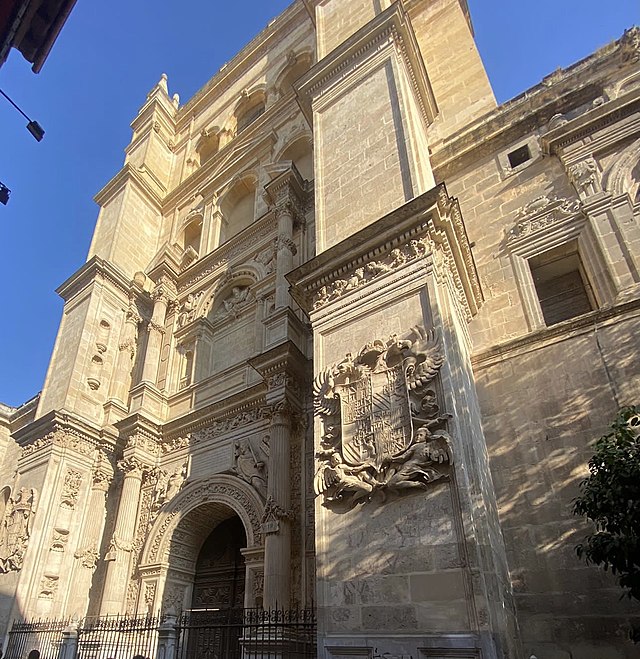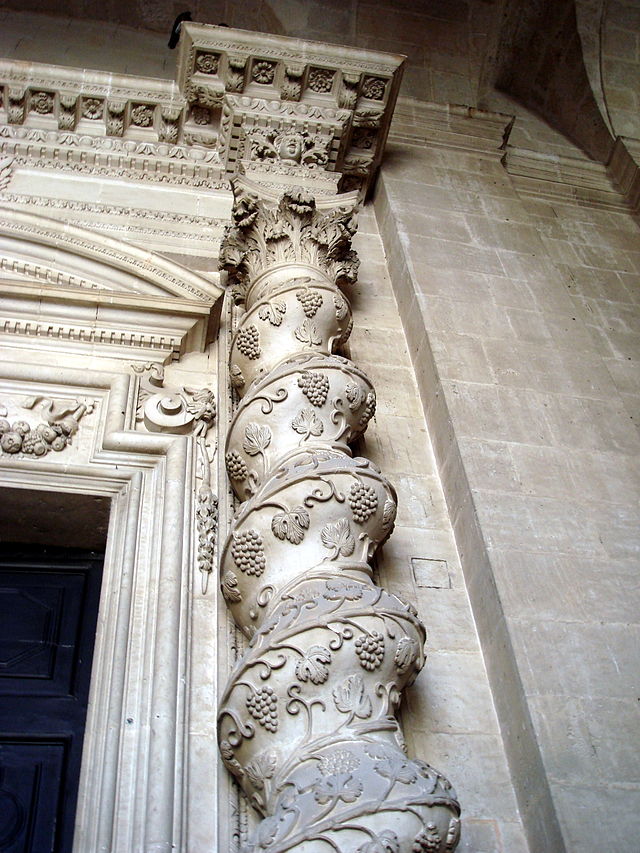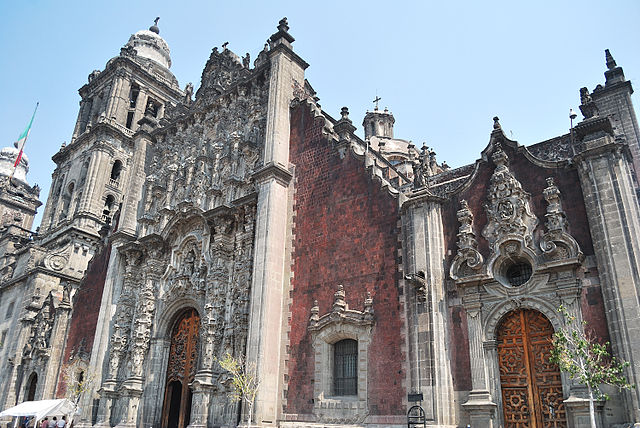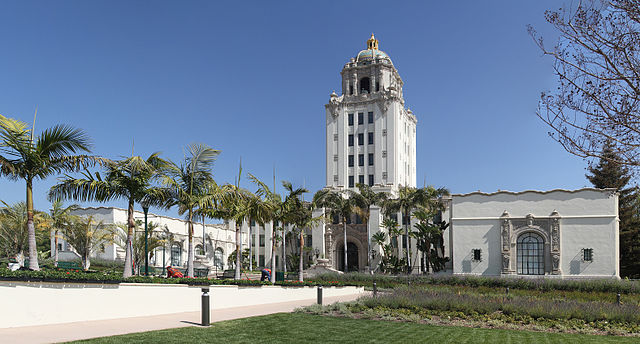Featured image credit: Geographer
And you thought Googie sounded exotic. Try wrapping your tongue around Churrigueresque! Believe it or not, this somewhat obscure architectural style is just as overwhelming on the eyes as it is the mouth. Subscribing to the “more is more” philosophy of the Baroque aesthetic, Churrigueresque is a highly decorative sub-style of Spanish Baroque. Due to its unrestrained ornamentalism, it’s sometimes referred to as “Ultra Baroque” or “Wedding Cake Architecture.” To be fair, its uber-opulence is more commonly mirrored in sugary icing than stucco and concrete. Yet, Churrigueresque began toward the end of the 17th century as a Spanish style of architecture that used stucco to achieve its painstaking detail. And while it flourished in Europe until about 1750, its influence continued across the Western world, even finding its way to sunny California.
The Origins of Churrigueresque

The Churrigueresque style owes its exotic name to noted Spanish architect José Benite de Churriguera. One look at the aesthetic and it should come as no surprise that he was also an accomplished sculptor. However, while Benite de Churriguera may be the movement’s namesake, he was not its originator. Alonsa Cana, another artist who worked in architecture and sculpture, owns that honor. He’s perhaps most revered for designing the intricate façade of the Catedral de Granada, completed in 1667.
Architects frequently used the florid, ornamental nature of Churrigueresque to emphasize entryways. Yet, it also served to revitalize stagnating architecture in several ways. At its crux, Churrigueresque creates a striking juxtaposition by placing the expressively ornate elements beside unassumingly plain surfaces. Therefore, the unusual style reinvented buildings by directly applying the pre molded concrete, stucco, or terra cotta designs to the original flat surfaces.
The Three Phases of Classic Churrigueresque Architecture
Historians have broken down the original Churrigueresque movement into three distinct phases:
Phase 1: 1680 – 1720
Italian architect Camillo Guarino Guarini elevated this phase, characterized by its liberal use of spiraling Solomonic columns and Classical composite order, to prominence. Additionally, the marrying of Solomonic columns and composite order would become known as “supreme order.”

Phase 2: 1720 – 1760
The Churrigueresque column, commonly referred to as the estipite column, characterizes the style’s second phase. Estipite columns incorporated inverted conical structures and obelisks to facilitate increasingly complex forms.
Phase 3: 1760 – 1780
The final phase of the movement popularized a concerted movement away from twisting Solomonic columns and highly ornate decorative frills. Instead, this phase infused the florid decadence of Churrigueresque with subdued neoclassical elements.
Crossing the Seas with Churrigueresque Style
With the popularity of Churrigueresque waning in the late 18th century, it’s a wonder the aesthetic ever graced a single Los Angeles edifice. But by then, Churrigueresque had made its way overseas, taking root in the work of several savvy architects. Chief among these was Lorenzo Rodriguez whose enthralling work pushed Mexican Churrigueresque to become arguably the most ambitious and decadent work in the style to date. Scholars of art frequently regard Mexico City’s Sagrario Metropolitano to be his crowning achievement.

Under Rodriguez’s influence, several Mexican architects began to apply Churrigueresque to Spanish Colonial structures. It was in the early 20th century that American architects Bertram Goodhue and Carleton Winslow, Sr. sought the inspiration of Mexican Churrigueresque when formulating designs for the ambitious Panama-California Exposition. Many see the buildings created for this 1915 Balboa Park-based fair as the genesis of the California Churrigueresque offshoot.
Fueling the Spanish Colonial Revival in California
The rise of Spanish Colonial Revival architecture across California is a story for another Architecture 101 blog. But it’s important to note that California Churrigueresque’s incorporation drove the widespread favor shown to the Spanish Colonial Revival style. In fact, a major reason why you rarely hear of Churrigueresque is because it was overshadowed in contemporary times by the Spanish Colonial Revival. However, it’s doubtful that the popular architecture style would have gained such remarkable traction without its Churrigueresque elements. The California mission style at its foundation was just too limited. With Churrigueresque, architects found a wealth of creative possibilities.
The Dawn of the California Churrigueresque Style
Balboa Park’s Panama-California Exposition served as the catalyst for California Churrigueresque’s wide use across the state. But it wasn’t actually the introduction of Churrigueresque in California. At least not physically. When Churrigueresque designs were published in anticipation of Goodhue’s and Winslow’s work for the California-Panama Exposition, they stirred considerable interest. Yet, with the fair still years away, the First Congregational Church in Riverside used those designs to beat the architects to the punch. Completed in 1914, the church makes liberal use of California Churrigueresque in its tower.
Examples of Churrigueresque Architecture in the Greater LA Area
Today, examples of California Churrigueresque can be found sparingly throughout the Greater Los Angeles area. Many in the area opted to label the style the phonetically simpler “Spanish.” But this lacks the specificity that such a grandiose style demands. If you’re curious to see examples of California Churrigueresque for yourself, the following local structures exemplify the style either wholly or in part:

- The Belasco – 1050 S Hill St, Los Angeles, CA 90015
- Beverly Hills City Hall – 455 N Rexford Dr, Beverly Hills, CA 90210
- Chapman Market – 3465 W 6th St, Los Angeles, CA 90020
- CVS/Golden Gate Theatre – 5176 Whittier Blvd, Los Angeles, CA 90022
- The First Congregational Church of Riverside – 3504 Mission In Avenue, Riverside, CA 92501
- Glendale Transportation Center – 400 West Cerritos Ave, Glendale, CA 91204
- Million Dollar Theater – 307 S Broadway, Los Angeles, CA 90013
- “Monkey” Building – 3285 Wilshire Blvd, Los Angeles, CA 90010
- St. Elizabeth of Hungary Catholic Church – 1879 N Lake Ave, Altadena, CA 91001
- St. Vincent de Paul Roman Catholic Church – 621 W Adams Blvd, Los Angeles, CA 90007
- Villa Carlotta Apartments (entryway) – 5959 Franklin Ave, Los Angeles, CA 90028
Read Los Angeles Architecture 101: Googie
Read Los Angeles Architecture 101: Craftsman
Read Los Angeles Architecture 101: Beaux-Arts
Read Los Angeles Architecture 101: Art Deco
With a brand that says as much as JohnHart’s, Senior Copywriter Seth Styles never finds himself at a loss for words. Responsible for maintaining the voice of the company, he spends each day drafting marketing materials, blogs, bios, and agent resources that speak from the company’s collective mind and Hart… errr, heart.
Having spent over a decade in creative roles across a variety of industries, Seth brings with him vast experience in SEO practices, digital marketing, and all manner of professional writing with particular strength in blogging, content creation, and brand building. Gratitude, passion, and sincerity remain core tenets of his unwavering work ethic. The landscape of the industry changes daily, paralleling JohnHart’s efforts to {re}define real estate, but Seth works to maintain the company’s consistent message while offering both agents and clients a new echelon of service.
When not preserving the JohnHart essence in stirring copy, Seth puts his efforts into writing and illustrating an ongoing series entitled The Death of Romance. In addition, he adores spending quality time with his girlfriend and Romeo (his long-haired chihuahua mix), watching ‘70s and ‘80s horror movies, and reading (with a particular penchant for Victorian horror novels and authors Yukio Mishima and Bret Easton Ellis). He also occasionally records music as the vocalist and songwriter for his glam rock band, Peppermint Pumpkin.


